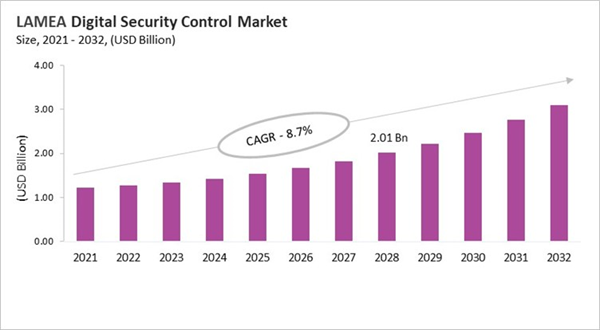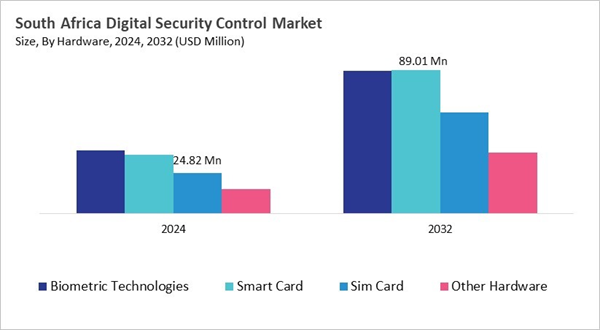The Brazil market dominated the LAMEA Digital Security Control Market by country in 2024, and is expected to continue to be a dominant market till 2032; thereby, achieving a market value of $813.6 million by 2032. The Argentina market is showcasing a CAGR of 11.8% during 2025-2032. Additionally, the UAE market would register a CAGR of 8.8% during 2025-2032. The Brazil and UAE led the LAMEA Digital Security Control Market by Country with a market share of 28.8% and 9.6% in 2024. The South Africa market is expected to witness a CAGR of 12% during throughout the forecast period.
The digital security control market in LAMEA has moved away from separate, analog, and manual systems like guards, locks, and CCTV, and toward integrated, digital, and network-driven solutions. The growth of infrastructure, smart city projects, and government rules that require safety and surveillance have all led to the use of IP-based cameras, biometrics, mobile credentials, and cloud-enabled systems. Demand is especially high at airports, transportation hubs, banks, and government buildings, where scalable, modular, and cyber-resilient solutions are becoming more important. OEMs are now making products with encryption, secure firmware, and privacy-aligned features because people are more worried about cybersecurity, data protection, and following the rules.
Global OEMs that offer end-to-end, certified systems for large-scale infrastructure compete with regional players that focus on cost-effectiveness, quick deployment, and adapting to local needs. Biometric authentication, touchless and mobile access, safe/smart city integration, and the merging of physical and digital security are all current trends. Some of the most important strategies are working with local companies, providing hybrid and modular solutions for different situations, following the rules, and adding lifecycle services like monitoring, maintenance, and managed security. In this market, trust, compliance, service reliability, and the ability to integrate are more important than just price.
Hardware Outlook
Based on Hardware, the market is segmented into Biometric Technologies, Smart Card, Sim Card, and Other Hardware. The Biometric Technologies market segment dominated the South Africa Digital Security Control Market by Hardware is expected to grow at a CAGR of 11.2 % during the forecast period thereby continuing its dominance until 2032. Also, the Sim Card market is anticipated to grow as a CAGR of 12.6 % during the forecast period during 2025-2032.Application Outlook
Based on Application, the market is segmented into User Authentication, Network Monitoring, Anti-Phishing, Web Technologies, and Security Administration. Among various UAE Digital Security Control Market by Application; The User Authentication market achieved a market size of USD $66.5 Million in 2024 and is expected to grow at a CAGR of 8.3 % during the forecast period. The Security Administration market is predicted to experience a CAGR of 10.5% throughout the forecast period from (2025 - 2032).Country Outlook
Brazil is the biggest digital security control market in Latin America because of its large population, fast urbanization, and need for important infrastructure. Integrated solutions are in high demand because of high crime rates, rising cyber-physical risks, and national modernization programs for smart cities and public safety. The need to protect ports, airports, and logistics hubs, as well as Brazil's data protection law, also affects market growth. AI-powered surveillance, biometric authentication, and cloud-based access platforms are some of the most important trends. These are very popular in the government and financial services. Multinational companies are in charge of big infrastructure projects, but local companies are better at system integration and following the rules. This makes Brazil the most important country in the region for digital security.List of Key Companies Profiled
- Cisco Systems, Inc.
- Palo Alto Networks, Inc.
- Check Point Software Technologies Ltd.
- CrowdStrike Holdings, Inc.
- Fortinet, Inc.
- McAfee Corp.
- Microsoft Corporation
- IBM Corporation
- Thales Group S.A.
- Trend Micro, Inc.
Market Report Segmentation
By Hardware
- Biometric Technologies
- Smart Card
- Sim Card
- Other Hardware
By Application
- User Authentication
- Network Monitoring
- Anti-Phishing
- Web Technologies
- Security Administration
By End Use
- Finance & Banking
- Healthcare
- Commercial
- Mobile Security & Telecommunication
- Other End-use
By Technology
- Two-Factor Authentication
- Three-Factor Authentication
- Four-Factor Authentication
By Country
- Brazil
- Argentina
- UAE
- Saudi Arabia
- South Africa
- Nigeria
- Rest of LAMEA
Table of Contents
Companies Mentioned
- Cisco Systems, Inc.
- Palo Alto Networks, Inc.
- Check Point Software Technologies Ltd.
- CrowdStrike Holdings, Inc.
- Fortinet, Inc.
- McAfee Corp.
- Microsoft Corporation
- IBM Corporation
- Thales Group S.A.
- Trend Micro, Inc.










